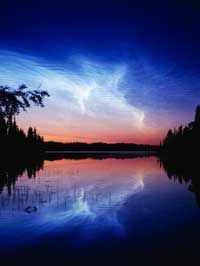Rare Clouds
Beyond the types of cloud already mentioned, there are a few others that offer some interesting, sky-gazing masterpieces.
Rare clouds include lenticular clouds and cap clouds, both examples of orographic lifting, mentioned earlier. Lenticular clouds, featuring layers and a distinctive swirl pattern that makes them resemble anything from spinning tops to pancakes, are formed by the terrain's effect on air movement. Cap clouds, which mask mountaintops, form by a similar process.
Advertisement
Contrail clouds are another interesting type of rare clouds. After jet planes release exhaust streams, these clouds form in the wake of this exhaust. Contrails occur when the upper atmosphere's cold air freezes the vapors in the jet planes' exhaust. These clouds usually fade quickly after the jet passes.
Probably the most fascinating rare cloud is the noctilucent cloud, also known as polar mesospheric clouds (the latter term if you're viewing them from space). The word noctilucent comes from "night" and "shining," and true enough, you can catch a glimpse of these rare clouds only at twilight, when they glow a vibrant blue in our atmosphere's highest reaches.
Perhaps the most intriguing thing about noctilucent clouds is that they may not have always been around. Their first recorded sightings came a few years after the 1883 eruption of Krakatau; and many people believe that the volcano and noctilucent clouds are related. Krakatau's violent explosion sent particles of ash, dust and moisture to incredible heights -- as high as 80 kilometers (262,467 feet) -- and the clouds began to develop.
As Krakatau's wide-reaching effects settled during the five years following the eruption, people assumed that noctilucent clouds would also fade. But these clouds still exist and are spreading. Many people believe Krakatau might have been the trigger, but they claim that other elements allow noctilucent clouds to stay around today.
Possible contributing factors of noctilucent clouds include:
- Space shuttles: Water vapor expelled in space shuttle exhaust could provide the clouds' moisture (similar to contrail cloud development).
- Pollution: The Industrial Revolution's pollution could have provided condensation nuclei for the clouds to develop. The effects of global warming actually decrease the temperature in the outer reaches of the atmosphere.
- Meteoroids: The near-constant influx of tiny particles of meteoroids could also contribute to the cloud formation.
If your head isn't in the clouds and you want to learn more about this topic, visit the cloud-related links floating lazily in the next section.
Related Articles
- How Acid Rain Works
- How Auroras Work
- How Light Works
- How Rainbows Work
- How Sunburns and Sun Tans Work
- How the Sun Works
- If the temperature is 30 degrees F, why do we sometimes get snow and other times get freezing rain?
- What does it mean when a barometer is rising or falling?
- What is relative humidity and how does it affect how I feel outside?
- Why is snow white?
More Great Links
Sources
- Britt, Robert Roy. "Weather 101: All About Wind and Rain." Live Science. (4/23/2008) http://www.livescience.com/environment/weather_science.html
- Davenport, Steve. "Noctilucent Clouds." MeteoGroup. 9/5/2007. (4/23/3008) http://www.meteogroup.co.uk/uk/home/weather/weather_news/ news_archive/archive/2007/may/ch/794bb3c5fa/article/ noctilucent_clouds.html
- Fraser, Alistair. "Bad Clouds FAQs." Pennsylvania State University. (4/22/2008) http://www.ems.psu.edu/%7Efraser/Bad/BadFAQ/BadCloudsFAQ.html
- Fraser, Alistair. "Bad Meteorology: The reason clouds form when air cools is because cold air cannot hold as much water vapor as warm air." Pennsylvania State University. (4/22/2008) http://www.ems.psu.edu/%7Efraser/Bad/BadClouds.html
- Harris, Richard. "Gas Cloud Headed for Milky Way Collision." NPR. 1/11/2008. (4/22/2008) http://www.npr.org/templates/story/story.php?storyId=18027001
- Joyce, Christopher. "Snow Flurries, Bacteria Likely." NPR. 3/3/2008. (4/22/2008) http://www.npr.org/templates/story/story.php?storyId=87761584
- Levine, Arlene. "Earth's Mysterious Atmosphere." NASA. 9/30/2002. (4/24/2008) http://asd-www.larc.nasa.gov/edu_act/clouds.html
- Libbrecht, Kenneth. "A Snowflake Primer." SnowCrystals.com. (4/24/2008) http://www.its.caltech.edu/~atomic/snowcrystals/
- NASA Cloudsat Publications. "Cloudsat." "The Importance of Understanding Clouds." Jet Propulsion Laboratory at the California Institute of Technology. (4/22/2008) http://cloudsat.atmos.colostate.edu/publications
- National Weather Service. "Clouds." 8/29/2007. (4/22/2008) http://www.srh.weather.gov/srh/jetstream/synoptic/clouds.htm
- National Weather Service. "How are clouds named and who named them?" (4/22/2008) http://www.wrh.noaa.gov/fgz/science/clouds.php
- O'Carroll, Cynthia. "NASA Satellite Captures First View of Night-Shining Clouds." NASA Goddard Space Flight Center. 6/28/2007. (4/24/2008) http://www.nasa.gov/mission_pages/aim/multimedia/first_view.html
- Palmer, Chad. "Understanding Clouds and Fog." USA Today Weather team. (4/22/2008) http://www.usatoday.com/weather/wcloud0.htm
- Phillips, Tony. "All the World's a Stage for Dust." NASA Science and Technology Directorate. 6/26/2001. (4/22/2008) http://science.nasa.gov/headlines/y2001/ast26jun_1.htm
- Phillips, Tony. "Dust Begets Dust." NASA Science and Technology Directorate. 5/22/2001. (4/22/2008) http://science.nasa.gov/headlines/y2001/ast22may_1.htm
- Phillips, Tony. "Night Clouds." NASA Science and Technology Directorate. 6/20/2003. (4/22/2008) http://science.nasa.gov/headlines/y2003/20jun_TMAclouds.htm
- Phillips, Tony. "Strange Clouds." NASA Science and Technology Directorate. 2/19/2003. (4/22/2008) http://science.nasa.gov/headlines/y2003/19feb_nlc.htm
- Plymouth State University Meteorology Program. "Cloud Boutique." (4/25/2008) http://vortex.plymouth.edu/clouds.html/
- University of Illinois. "Clouds and Precipitation." (4/25/2008) http://ww2010.atmos.uiuc.edu/(Gh)/guides/mtr/cld/home.rxml
- Schroder, Wilfried. "Were Noctilucent Clouds Caused by the Krakatoa Eruption? A Case Study of Reaserch Problems before 1885." Bulletin of the American Meteorological Society. 4/20/2008. (4/24/2008) http://ams.allenpress.com/archive/1520-0477/80/10/pdf/ i1520-0477-80-10-2081.pdf
- Tarbuck, Edward and Lutgens, Frederick. "Earth Science Eleventh Edition." Pearson Prentice Hall. 2006. (4/28/2008)
- Williams, Jack. "Molecular motion determines water's state." USA Today. (4/22/2008) http://www.usatoday.com/weather/tg/wevapcon/wevapcon.htm
